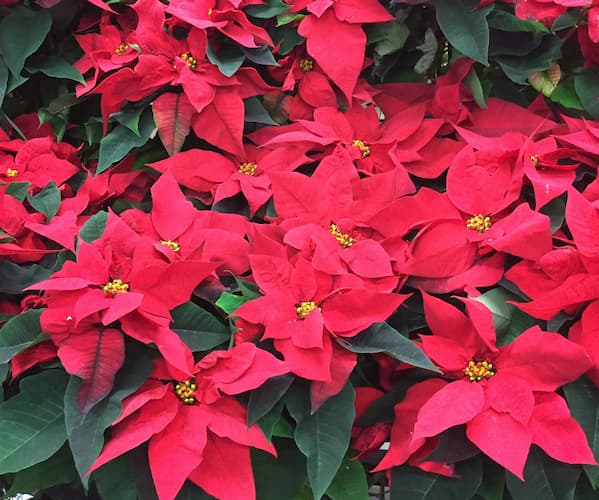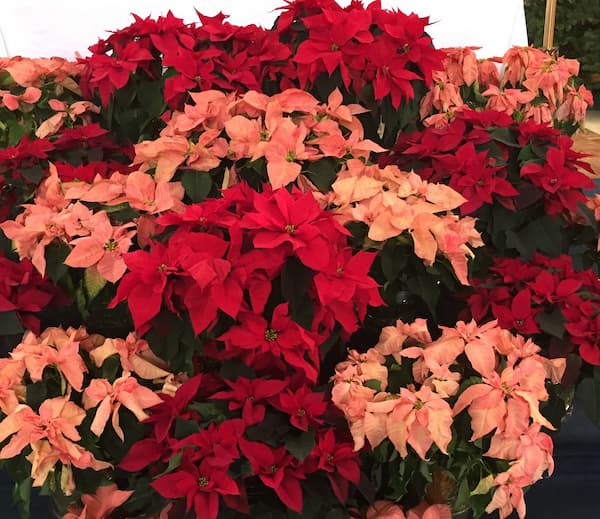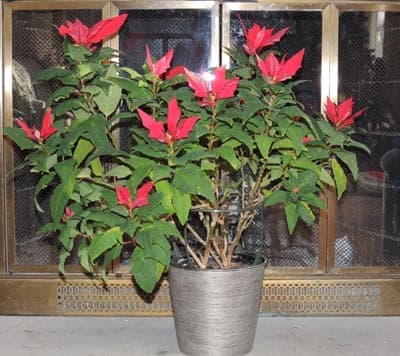How to Grow Poinsettia Plants and Forcing Poinsettias to Bloom

About Poinsettia Flowers and Plants
Originally from Mexico and Central America, Poinsettia plants are by far the most popular flower plants during Christmas. They are the largest flowering plant crop in the U.S. with sales of over 70 million pots! The plants don’t naturally bloom in December. Rather, in early, Fall, nurseries begin forcing Poinsettias to bloom. The process takes several weeks. Long-lasting poinsettia blooms last into January and February. Also, if you have a plant in the house from last year, you can force it to bloom. Our guide on “How to grow Poinsettia plants” gives you all the information you need to grow them and get them to bloom during the holidays.
Native to the warmer southwestern U.S. climates and Mexico, Poinsettias are susceptible to cold and frost. So, when you bring them home in cold weather, make sure to bring them right home. Don’t leave them in your car and go back to your Christmas shopping.
There are over 100 varieties of this plant. These perennial plants are trees that can grow 10-15 feet in the wild. Poinsettia blooms are not actually flowers. Rather, they are leaves called “Poinsettia Bracts”. The traditional red poinsettias plants are by far the most popular. There are several other Poinsettia Bract colors including pink, white, salmon, yellow, and multi-colored bracts.
Poinsettia flowers are named after Joel Roberts Poinsett, the first Ambassador to Mexico who brought the plant back to his plantation in the U.S. He was also a botanist and a physician. Poinsett grew the plants in his Greenville, S.C plantation and gave them out as gifts to friends.
Did you Know? Poinsettia Day is December 12th. It was declared in honor of Joel Roberts Poinsett who died on December 12, 1851.
Poinsettias are not poisonous as many believe. But, eating them could give you a stomachache. You’d have to eat a lot of the leaves to get sick.
Poinsettia Plant Specifications
Flower Colors: Traditional bright red is by far the most popular color. Other flower colors include pink, salmon, white, yellow, and multi-colored.
Flowers Bloom: Depending upon where you live, they bloom at any time from October to April.
Plant height: 12 inches to 18 feet, depending upon variety.
Ideal Soil pH: 6.0 – 7.6
Hardiness Zones: 9 – 11
Light Requirements: Diffuse, partial sunlight.
Is the Plant Toxic? Yes. It is mildly toxic to humans and pets.
Deer Resistant? Yes. The plants have a strong scent and a bitter flavor. As a result, deer, rabbits, and other foraging animals normally avoid it.
Native To: Mexico.
Number of Species: There are 100 varieties.
Plant Type: Perennial shrub.
Botanical Name: Dianthus Plumarius
Other Names: Poinsettias are also called Christmas Plant, Christmas Star, “Lobster Flower” and Flame-Leaf Flower”. In Chile and Peru, they are called “Crown of the Andes”.
Are Poinsettia Plants Edible?
NO!
The plants are mildly toxic to humans and pets. It can cause mild stomachaches. And, it can cause a mouth rash.
Keep this plant away from young children.
Medicinal Applications for Poinsettia Plants
Despite its mild toxicity, Poinsettia plants have several medicinal uses. Here are a few of them:
- It eases symptoms of asthma.
- It is used to treat a variety of ailments including eczema, gonorrhea, and malaria.
- Dried sap offers pain relief.
- It aids in breast milk production.
- It alleviates fever.
- Use it for respiratory infections.

Poinsettia Trivia
- Poinsettias area also called “Christmas Plant”, “Lobster Flower” and “Flame-Leaf Flower”.
- The poinsettia blooms are actually leaves called “Brachts”.
- Red is the most popular flower color. However, there are many other colors, including white, pink, green, salmon, blue, purple, and yellow. The are bi-color and variegated varieties, too.
- Botanists develop different colors by varying the amount of light the bracts receive.
- German botanist Wilenow gave the poinsettia its botanical name, Euphorbia pulcherrima, which means “very beautiful.”
- They are the highest-selling potted flowering plant in America.
- The top producing state is California.
- During Joel Roberts Poinsett’s day, many botanists considered the plant to be a weed.
- Leaves can measure 6 to 8 inches across.
- The sticky white sap causes skin irritation in some people.
- The Aztecs used the sap to control fevers and the red bracts for making red dye.
- National Poinsettia Day is in December.
- Those poinsettias decorating your home in containers are actually a tree. In the wild, the plants can grow up to 15 feet tall.
Light Requirements
Poinsettia plants grow best in full, but diffuse sunlight. Too much direct sunlight can burn the leaves and bracts. Give the plant six to eight hours of sunlight.
It will also grow in lower, partial sunlight. However, if light levels become too low, the plant begins to lose its leaves.
How to Grow Poinsettia - Selecting Healthy Plants
Look for lots of dark green leaves and bright colored flowers, called Bracts. If either the leaves or the flowers are dry or brown around the edges, select another plant. Look for completely open flowers. Poinsettia blooms are slow to open, but once they bloom, the flowers will remain full and attractive for several weeks. Plants blooming in the stores during the holidays often remain as late as February!
Also, it is important to look for insects on the plant or the soil. If you spot them, we recommend going to another store to purchase them as other plants may harbor them.
If the weather is cold, make sure to wrap up the plant well for the trip from the store to the car. Even short exposure to cold and wind can damage your new Poinsettia plant before it is even home.
Poinsettia plants are propagated by seeds. However, the seeds are difficult to find. Plants sold on the market are forced to bloom for sale during the Christmas season.
How to Grow Poinsettia Plants
Poinsettias are easy to keep. They will retain their blooms long after you have put away the Christmas decorations. If you are lucky, they will last until Valentine’s Day. After bringing them home, keep them in a warm room. Place it at or near a window that offers indirect light. The ideal temperature range is 60 – 70 degrees. Also, it is important to avoid areas where there is a cold draft. So, do not place them near an entryway door. And, they do not like being placed near high heat like a furnace vent or fireplace.
Water thoroughly, then let the soil dry between watering. Poinsettias are forgiving. If they begin to dry out, water them and they bounce right back. If the leaves turn lighter green, give more sunshine, and……they bounce right back.
For growing poinsettia plants during the summer, you can move your plant outdoors to a partially sunny location. Plant it directly into your garden or a container. Give the plant a good trim. Form it into a nicely rounded shape. Apply general-purpose fertilizer every two to three weeks.
Also, you can grow them in a flowerpot on your balcony or deck. Then, as cool weather sets in, bring the plant and flowerpot indoors. Check the plant and soil for bugs before bringing them inside.
Bring the plant indoors before the first frost. Poinsettias cannot withstand frost. Check carefully to be sure you did not bring in any “critters” with your plant.
Poinsettia blooms are long-lasting. They continue to bloom into late January to early February. After the flower bracts wither and die, prune them off. Then, trim and shape the plant, if necessary.
Did you know? Poinsettias can grow up to 18 feet. But, to grow them this big you will need the right variety, and few years in a tropical climate that does not experience frosts.
Also see: Bringing Plants Indoors

Forcing Poinsettias to Bloom
The poinsettia plant above was forced at home, following the instructions below. Because we did not have a grow light on it during the daylight hours, the leaves were not as full and lush as a store-bought plant. But, as you can see, it certainly came out beautifully!
Forcing Poinsettias to bloom is not the easiest task. But, when you succeed, it is highly rewarding. if you have kept them around and healthy all year, you’ve just gotta give it a try.
The concept of forcing poinsettias to bloom is simple enough. Any time from late September to October first, you need to put the plant in total darkness for 12-14 hours a day. Here is where it’s tricky. Any small light can upset the process. During the day, it should get six hours or more of sunlight. Continue this process daily until early November, then bring it out into the room. Now with a little luck (some will say a lot of luck) and your personal green thumb, you will see poinsettia blooms in time for the Christmas holiday.
Tip: A black plastic bag works well. Place the plant in the bag and use a twist tie. Each morning, remove the twist tie and carefully lower the bag to the floor.
Related Articles
Also, people who read this article on Poinsettia flowers will like:
Please support our site. Shop for:
- rmmatthews100@hotmail.com
- 585-721-6528
- Rochester, NY
©1999-2024 GardenersNet.Com, All Rights Reserved

